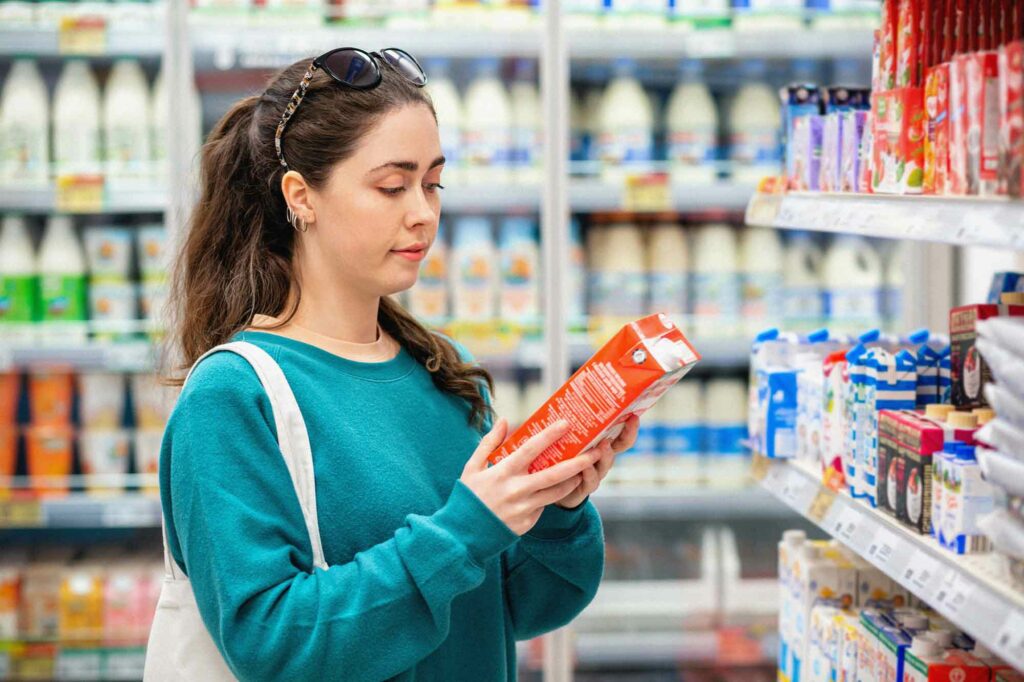In the intricate world of food and beyond, understanding allergens is paramount for the well-being of individuals and the integrity of industries, so let’s dive into the complexities of allergens. From understanding the definition of an allergen, to the categories they can be broken down into, we’ll explore the risks of allergens to people, and the common signs and symptoms that occur from exposure to them.

Allergen-free products are being seen more and more on shelves, due to the measures taking place to safeguard individuals with allergies, however, there are many complexities and challenges of meeting it. Correct allergen-labelling and avoiding cross-contamination are both vital protecting those at risk, with laws being implemented to ensure they take place.
What is an Allergen?
Allergens are substances, typically a protein or peptide, that cause allergic reactions. These reactions occur when an allergen comes into contact with, or is ingested by, a susceptible individual and their immune system produces antibodies to fight this ‘harmful’ substance, leading to an allergic reaction. This immune response can result in a range of reactions, from mild to severe and potentially life threatening. Nearly any food can trigger an allergic reaction however there are 14 foods that cause most reactions varying from mild to severe reactions. Identifying and avoiding exposure to allergens is crucial for individuals with allergies to manage their condition and prevent possible adverse reactions.
The 14 Allergens
| Allergen | Nature | Source | Prevalence |
| Celery | Celery, celery stalks, leaves, spice, celery salt | Salads, soups, stews | Less common than some allergies, but reactions can range from mild to severe. |
| Gluten | Wheat, barley, rye, oats | Foods containing flour: – Bread – Baked goods – Cereals – Pasta Barley-based products: – Beer – Malt – Malt-vinegar – Food colouring | Affects about 1% of the global population and it can vary in severity. |
| Crustaceans | Shellfish with a hard exoskeleton | Crab, lobster, shrimp, prawn | More common in adults, and prevelance varies globally. This can be severe, with reactions varying from mild to anaphylaxis. |
| Eggs | Protein found in eggs | Cakes, mayonnaise, mousses, pasta, quiche, food brushed with egg, some meat products | Common in childhood, however often outgrown. Reactions can range from mild to severe. |
| Fish | Protein found in fish | Salmon, tuna, cod, etc. | Common and can develop at any age. Fish allergies can be severe, and reactions may occur with minimal exposure. |
| Lupin | Protein found in Lupin seeds | Lupin flour in some breads, pastries and pastas | Not as common as other allergens. |
| Milk | Protein found in milk | Milk, butter, cheese, cream, yoghurt, foods glazed with milk | Most common in infants, and many outgrow by adulthood. Reactions can be severe. |
| Molluscs | Shellfish with a soft body | Clams, mussels, oysters | Less common than crustacean allergies but reactions can still be severe. |
| Mustard | Proteins founds in mustard seeds | Mustard, breads, curries, marinades, meat products, salad dressing, sauces, soups | Possible but less common. Reaction severity varies among individuals. |
| Nuts / Tree nuts | Proteins found in various tree nuts | Almonds, hazelnuts, cashews, pecan nuts, Brazil nuts, pistachio nuts, macadamia nuts | Nut allergies can be severe, with a risk of anaphylaxis and often persist into adulthood. |
| Peanuts | Proteins found in peanuts | Peanuts, peanut butter, biscuits, cakes, curries, desserts, sauces | Peanut allergies affect around 1-2% of the population. Often lifelong and can be severe, potentially resulting in anaphylaxis. |
| Sesame Seeds | Proteins found in sesame seeds | Bread, hummus, some garnishes, sesame oil, tahini (sesame paste) | Sesame allergies are becoming more recognised and reaction can range from mild to severe. |
| Soya | Proteins found in soybeans | Desserts, ice cream, meat product, tofu, soy sauce | Common, especially in infants and children. reactions range from mild to severe. |
| Sulphur Dioxide (Sulphites) | Preservatives used in various foods | Dried fruits, wine, processed foods | Asthmatics may be more susceptible to sulphite sensitivity . |
Risks of Allergens to People
Allergens can pose a significant risk to individuals and exposure can lead to a range of adverse reactions, varying in severity.
The most common signs and symptoms of food allergies include:
Skin Reactions
- Hives
- Eczema
- Itching or tingling sensations
Gastrointestinal Symptoms
- Abdominal pain
- Nausea
- Diarrhea
Respiratory Symptoms
- Sneezing
- Coughing
- Wheezing
- Shortness of breath
Oral Allergy Syndrome (OAS)
- Tingling sensations in the mouth, lips or throat
- Swelling of lips, tongue or throat
Cardiovascular Symptoms
- Rapid or irregular heartbeat
- Low blood pressure
- Fainting or light-headedness
Anaphylaxis (severe allergic reaction that can result in death)
- Sudden drop in blood pressure
- Difficulty breathing
- Potential loss of consciousness
Allergens can also have an emotional impact. The constant fear of accidental exposure and the need for persistent caution can result in anxiety and stress, for both the individual and the people they have around them. Dining out, attending social events and travelling can all become challenging if dealing with a life-threatening food allergy.
Allergen-Free – Criteria and the challenges of meeting it
Allergen-free means that a product or substance is free of specific allergens, implying that the product does not contain any ingredient that is known to cause allergic reactions, catering to individuals with allergies. However, allergen-free, in some cases, doesn’t mean something is entirely free from said allergen. Gluten and Sulphur dioxide are examples of this.
If a “gluten-free” product contains less than 20mg/kg (or parts per million (ppm)) it can be considered gluten-free as it is still safe to be consumed by most of those with a coeliac disease. Although not a legal requirement, some industrial manufacturers require less than 5mg/kg (ppm) from ingredients for their applications.
Sulphur Dioxide possesses a legal limit of 10 ppm. However, there is a bit of a grey area in that naturally occurring Sulphur Dioxide does not have to be declared, only when it is added must it be declared. An example of a product that contains naturally occurring Sulphur Dioxide is mustard.
If a finished product has any added Sulphur Dioxide, then the naturally occurring levels must be included in the calculation and the level in the final product must be less than 10ppm if a free from is to be declared.

To note, not all countries recognise the same allergens. For example, mustard is not recognised in the US.
Criteria of labelling a product allergen free and their challenges:
Ingredient Selection
- Products should not contain common allergens.
- Maintaining control over an entire supply chain is challenging. This means that it’s essential that manufacturers communicate with suppliers who must provide assurance that ingredients and packaging materials supplied are free from allergens and manufacturers must monitor this.
Cross-Contamination Prevention
- Measures must be taken to prevent cross-contamination.
- The risk of cross-contamination during production is a primary challenge in keeping a product allergen-free. Even trace amounts of allergens from shared equipment or surfaces can affect the ‘allergen-free’ status.
Testing and Certification
Products undergo testing to verify they meet specific allergen-free standards (certification from recognised organisations provide additional assurance).
Labelling and Disclosure
Ingredients must be clearly listed and labelled on packaging.
Facility Allergen Management
Manufacturers should implement robust allergen management practices within their facilities, including training on allergen awareness, segregation of allergen-containing ingredients and implementation of cleaning procedures to prevent cross-contamination.
Achieving and maintaining an allergen-free product requires a comprehensive approach involving ingredient control, production processes, testing, and strict adherence to labelling standards. These challenges associated with cross-contamination and the need for industry-wide standard highlight the complexity of delivering products that meet the criteria of, and genuinely are allergen-free.
The Risks of Cross-Contamination
Cross-contamination occurs when traces of allergens get into products accidentally during the manufacturing, handling, transportation or storage of foods. It poses significant risks for individuals with food allergies. Cross-contamination occurs when an allergen contaminates a product that is supposed to be ‘allergen-free’, leading to unintended exposure. This exposure can result in an unexpected allergic reaction that could be severe and possibly fatal, indicating the importance of ensuring that cross-contamination does not occur throughout every phase of a products production process. So, what can you do to reduce the risk of cross-contamination? Closed-loop manufacturing.
What is closed-loop manufacturing?
A comprehensive and controlled system that integrates various stages of production, creating a continuous and self-regulating cycle. In this system, resources are recycled, waste is minimised, and environmental impact is reduced. In the context of food manufacturing, a closed-loop system involves tightly integrated processes from ingredient sourcing to production, packaging, and distribution, ultimately aiding the prevention of cross-contamination and accidental allergen exposure.
Closed-loop manufacturing is pivotal in preventing accidental allergen exposure through the following ways:
Ingredient Control
This ensures control over ingredient sourcing, tracking and verifying the allergen status of each ingredient, minimizing the risk of introducing allergens into the manufacturing process.
Production Line Segregation
- Closed-loop systems facilitate the segregation of production lines for different products, especially those with and without allergens, minimising the chance of cross-contamination during manufacturing. This includes the segregation of ingredients and products during transportation and storage.
- Segregation during transportation and storage isolates ingredients and products, eliminating the risk of cross-contamination.
Allergen-Free Packaging
From production to packaging, closed-loop systems ensure that materials used are free from allergens. This includes packaging materials that come into direct contact with the product, reducing the risk of contamination.
Cleaning Protocols
Closed-loop manufacturing emphasises rigorous cleaning protocols. Between production runs, equipment is thoroughly cleaned to eliminate any traces of allergens, further preventing cross-contamination.
Automated Monitoring and Control
Automation within closed-loop systems enables real-time monitoring and control of production processes. This reduced the reliance on manual interventions, minimising the risk of human error leading to allergen exposure.
How can you ensure closed-loop systems?
Comprehensive training
- Thorough training should be provided for employees that operate within the manufacturing process. You should ensure they understand the significance of cross-contamination and how a closed-loop system can help prevent this.
Regular audits and inspections
- Regular audits and inspections can help identify and resolve potential failures in allergen control.
Supplier verification
- Implementing supplier verification processes to ensure that all your ingredients received from suppliers meet allergen-free specification. You should maintain clear communication with suppliers regarding allergen control.
Utilise allergen-free zones
- Designating specific ‘allergen-free zones’ within your manufacturing facility. This can help maintain separation and reduces the risk of cross-contamination.
Invest in technology
- Allergen detection tools and automated monitoring systems can enhance the efficiency of your closed-loop system, whilst also aiding the identification of potential contamination and system failures.
Allergen Labelling and Legislation
Pre-packaged food items must feature a comprehensive ingredients list, where allergenic ingredients are consistently highlighted, usually in bold or underlined. It is mandatory to explicitly identify allergenic ingredients to ensure clear comprehension. Allergen advice statements may be incorporated into product labels to give explanation on how and where allergen details are presented. In instances where alcoholic beverages lack an ingredients list, allergens must still be indicated by the term ‘contains’, followed by the specific allergen. For the full legislation on labelling aimed at food manufacturers, you should refer to the UK Government Food Standards Agency.
Allergen Labelling lookouts
Precautionary allergen labelling
- In the presence of a possible risk of cross-contamination in a food item, the label must include one of the following statements:
- “May contain X”
- “Not suitable for someone with X allergy”
- The use of precautionary allergen labelling is permissible only after conducting a thorough risk assessment.
Free-from labelled foods
- Free-from food are special ranges of products produced without allergens. When a product claims it’s ‘free-from X’, stringent controls are in place to ensure the absence of the specified allergen. Additionally, measures are implemented to prevent cross-contamination from other foods produced on-site.
- An exception to this rule, as mentioned earlier, is gluten. Products labelled as gluten-free may contain a maximum of 20 parts per million (ppm) of gluten. This threshold is considered safe for most people with celiac disease.
Language on the label
- Labelling should use language that is easily understandable to the residents of the country in which the food is being marketed. In the case of food items marketed in the UK, the information must be presented in English.
Multipacks
- If you include allergen information on the packaging of individual items, it must align consistently with the information on the outer packaging.
Examples of improper allergen labelling
Pret A Manger, the well-known British sandwich shop, has been featured in the news over the last few years due to, on multiple occasions, customers having severe allergic reactions to their products, some resulting in deaths. These occurred due to their failure to list ingredients on packaging and cross-contamination of allergens in products sold within their establishments.
In 2015, a 17-year-old girl collapsed and required emergency medical attention after suffering from a severe, life-threatening, allergic reaction to sesame in a product purchased within Pret A Manger. This is an example of the importance of listing ingredients on packaging, as sesame was not mentioned on the product labelling. The girl’s mother cautioned Pret that “other serious incidents could easily occur” due to the lack of suitable allergen labelling.
However this was the case, just months later. In 2016, 15-year-old Natasha Ednan-Laperouse died from an allergic reaction after collapsing on a flight from Heathrow airport, where she had purchased and subsequently consumed an artichoke, olive and tapenade baguette from Pret a Manger, which did not list sesame as an ingredient. Pret admitted to its products not individually being labelled with allergen information, but instead possessing signs on shelves and at tills telling customer to speak to the manager who had received training on providing allergen advice.
In the following year, Celia Marsh, who possessed a severe dairy allergy, passed away due to an allergic reaction after eating a ‘vegan’ wrap. The wrap contained traces of dairy after being contaminated with milk-protein.
These cases show the importance of precautionary allergen labelling and implementation of closed-loop systems to reduce the chance of contamination, possible allergic reactions and in serious cases, death. In the aftermath of Natasha Ednan-Laperouse’s passing, a law was implemented to protect people who suffer from food allergies and rely on the clarity of ingredients and food labelling. The suitably named ‘Natasha’s Law’ was implemented in October 2021 and must be followed by food businesses in England, Scotland, Wales and Northern Ireland.
The Key Features of Natasha’s Law
- PPDS
‘Prepacked food for direct sale’ (PPDS) was identified as the main target products for Natasha’s Law. They must be suitably labelled to avoid the possible accidental consumption of food allergens.
- Full ingredients list
The law mandates that pre-packed food products must display a full ingredients list, specifying and emphasising on allergenic ingredients present within the product.
- Allergen information in plain English
Allergens within the ingredients list must be presented in a conspicuous manner and in plain English, allowing easier identification.
- Cross-contamination information
In addition to listing allergens, the law encourages the provision of information about step taken to prevent cross-contamination. Vital for consumer with severe allergies.
Failure to comply with Natasha’s Law could result in serious reputational damage as well as possible criminal prosecution.
Examples of Restaurants Providing Adequate Allergen Information
Many restaurants provide allergen information on their menus, with common allergens listed next to each dish.
Pizza Express is a great example of this. The popular pizzeria chain possesses allergen information on their that allows clear identification of allergens present within dishes on their menu. They have done this by using a colour-coded system identifying celery (yellow), cereals (green), crustaceans (blue), eggs (black), fish (grey), sulphites (pink) and nuts (red) next to each selection on their menu.
Other restaurants, such as Zizzi’s and Bella Italia, possess interactive online menus that allow customers to filter food by allergy, removing dishes that contain the allergens selected. This creates a much clearer and more simple selection and ordering process for customers suffering from food allergies, whilst also reducing the chance of possible accidental consumption of dishes containing food allergens.
Examples of Allergen Menus
- Pizza Express Allergen Menu
- Zizzi’s Allergen Menu
- Bella Italia Allergen Menu
- Nando’s Allergen Menu
- Carluccio’s Allergen Menu
- GBK Allergen Menu
- Wagamama Allergen Menu

Allergens Summary
Allergens are substances that cause allergic reactions, and the understanding of them within the food industry is a complicated challenge with critical implications for public health.
The 14 Allergen groups: Celery, Gluten, Crustaceans, Eggs, Fish, Lupin, Molluscs, Mustard, Tree Nuts, Peanuts, Sesame, Soya, and Sulphites. Each vary in prevalence and severity. However, most allergic reactions can possess similar signs and symptoms. These include skin reactions, gastrointestinal symptoms, respiratory symptoms, Oral Allergy Syndrome (OAS), cardiovascular symptoms, and Anaphylaxis, the most severe symptom, that can result in death.
The journey to achieving a truly “allergen-free” products is filled with complexities and challenges. Specific criteria is required to be followed to achieve “allergen-free”, these being ingredient selection, cross-contamination prevention, testing and certification, labelling and disclosure and facility allergen management.
Cross-contamination is a serious threat to those possessing allergies as it can result in the accidental exposure to allergens. Measures must be put in place throughout every phase of the productions process to ensure that it doesn’t occur. Closes-loop manufacturing is a system undertaken to ensure this. It involves ingredient control, production line segregation, allergen-free packaging, cleaning protocols, and automated monitoring and control.
The positive impact of stringent regulation, exemplified by Natasha’s Law, highlights a crucial step towards safeguarding individuals with allergies, with the events at Pret A Manger emphasising the ongoing need for caution in preventing allergen related risks.
How can we help?
Lehmann Ingredients have a 35-year history in the sourcing and supply of ingredients for customers both in and outside of the UK. We are trusted suppliers of a wide variety of premium quality ingredients to a number of established companies from startups, to more established companies leading in various retail categories such as cereals and sports nutrition.
Food safety is paramount here at Lehmann Ingredients and we embody this through our dedication to help others understand the complexities of allergen navigation. If you have any questions about allergens or you wish to discuss your own supply chain needs, you can contact a member of our team by emailing enquiries@lehmanningredients.co.uk or calling +44 (0) 1524 581560.
